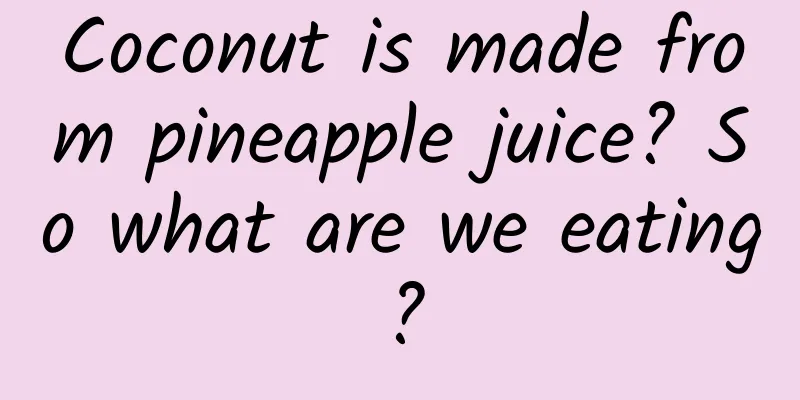Coconut is made from pineapple juice? So what are we eating?

|
Audit expert: Zhang Yufeng PhD/Associate Researcher, Coconut Research Institute, Chinese Academy of Tropical Agricultural Sciences For many contemporary young people, no matter how hard and difficult work and life are, as long as they have a cup of happy milk tea, many worries can be temporarily put aside. Of course, drinking milk tea is inseparable from various condiments. Although the condiment family is growing, "coconut fruit", as a veteran player, is still loved by many consumers for its chewy and bouncy texture. Coconut, from the name, seems to be related to coconut, but is it really so? Let's take a look. Source: Baidu Encyclopedia 1Is coconut fruit related to coconut? Coconut is the fruit of the coconut tree, which belongs to the genus Cocos in the palm family. Its outer shell has a three-layer structure, namely the exocarp, mesocarp and endocarp. The exocarp is a thin, smooth green skin (the exocarp of new varieties of coconuts can also be yellow, red, brown, etc.), the mesocarp is a highly fibrous structural substance, and the endocarp is a brown, bony shell. When a mature coconut is cut open, the endosperm can be seen. There are two types of coconut endosperm. One is solid endosperm, which is milky white in color and attached to the endocarp. This is what we often call coconut meat , which can be eaten directly or used to make coconut flakes, coconut juice, coconut oil and other products. Source丨The use of coconut in rituals and food preparations in India The other is liquid endosperm, which exists in the cavity inside the coconut. It is white and transparent in color, which is what we often call "coconut water". Source: pediaa.com Friends who have bought coconuts should know that there are three common types of coconuts on the market: one with a green skin, one with a hairy skin, and one with a smooth brown skin. The difference between these three types of coconuts lies in their maturity. Coconuts with green skin are young coconuts , which are less mature. At this time, they contain more coconut water and less coconut meat. Source: Baidu Encyclopedia As the maturity increases, the young coconut gradually "ages" and the exocarp turns from green to yellow and then brown. At this time, when the exocarp is peeled off, it will appear hairy. This is a hairy coconut . The coconut water inside this coconut has been reduced and partially converted into coconut meat. Source: Baidu Encyclopedia A fully mature coconut (that has not yet sprouted) with its exocarp and mesocarp removed and then polished is called a royal coconut. The coconut water content inside the royal coconut is further reduced and the thickness of the coconut meat is basically at its maximum. So, where does the coconut fruit in milk tea come from? The answer is coconut water! In 1886, scientists discovered a gel film floating on the surface of liquid during the vinegar-making process. After analysis, they defined it as bacterial cellulose (BC). It has high water and cellulose content and is suitable for being made into dietary fiber (DF) food after processing. By the 1940s, the Philippines, Vietnam and other places chose to use coconut water, which was abundant in local resources, as the culture medium for fermentation and production of bacterial cellulose, so the resulting bacterial cellulose was called "coconut fruit". According to the definition of my country's agricultural industry standard NY/T 1522-2007, the cellulose gel substance formed after fermentation with coconut water or coconut juice (milk) as the main raw materials is called coconut fruit, also known as coconut fiber fruit. Source: Baidu Encyclopedia 2How to make coconut jelly? Although the coconut water content in mature coconuts is generally less than that in young coconuts, they are usually used as raw materials for coconut fiber fermentation due to their lower cost. The coconut meat after collecting the coconut water will not be wasted. It can be ground into coconut flakes or squeezed to produce coconut milk, and further processed into coconut oil, coconut sugar, coconut juice and other foods. In recent years, as the price of coconut water has risen, the industry has begun to use other ingredients such as pineapple juice to produce coconut nut. The production of coconut fruit by fermenting coconut water generally includes the following steps: First, it is necessary to filter out the impurities in the collected coconut water, then add sucrose, NH4Cl, MgSO4, yeast paste, citric acid and other ingredients, adjust the pH value, and after heating, cooling and other operations, create a suitable environment for the growth of the bacteria. The secret weapon in producing coconut nata is a special bacterium called Acetobacter xylinus . The Acetobacter xylinum is placed in the prepared culture medium for fermentation for about 2 weeks. During the fermentation process, the Acetobacter xylinum will metabolize the sugars in the culture medium to produce bacterial cellulose. Bacterial cellulose has a low density and floats on the surface of coconut water. After a large amount of bacterial cellulose gathers, it gradually forms a layer of white transparent gel. Coconut gel Source: Captain Dolphin Afterwards, this layer of gel substance is subjected to high-temperature steaming, sterilization, cutting, sorting, and other processes to become the coconut fruit we see today. Coconut cut by cutting machine Source: Captain Dolphin In general, the main component of coconut fruit is bacterial cellulose. Like plant fiber in fruits and vegetables, bacterial cellulose cannot be digested and absorbed by the human body. It is not only low in calories, but also helps promote gastrointestinal motility. However, the coconut products we eat will have a lot of sugar, sweeteners and other auxiliary materials added to them to enhance the flavor, so the coconut ingredients in milk tea also have certain calories. Source: Baidu Encyclopedia The development of coconut nut technology has become mature. In my country, the industrial application of coconut nut is very extensive. Coconut nut can not only be used as a small ingredient for milk tea, but can also be used in the health food industry. For example, the strong water absorption of coconut nut and the active hydroxyl groups in the dense cellulose network can be combined with a variety of herbal extracts to develop various health coconut nut foods. However, at present, the coconut products in the domestic market are still relatively simple, and the public's impression of coconut is still limited to traditional beverages. As a coconut lover, I hope that in the near future, we can eat more coconut delicacies~ |
<<: What's in a bird's nest? Much more than twigs and straw...
Recommend
Guangming Daily: Self-media is destroying the language of a generation
If we believe that high-quality reading is meanin...
Wuhan tea drinking sn tea friends recommend sharing tea tasting health high-end club
Wuhan health tea consultation 132-7243-3196 (sync...
These vegetables are simply "natural MSG", boiled in water = "vegetarian soup" that's so delicious it's eyebrow-dropping
A pot of delicious and refreshing soup with diver...
Xiaohongshu Promotion丨How to quickly create popular notes!
I have a strong interest in customer acquisition,...
You can get in just by paying! APP Promotion Offline Pre-installation Promotion Manual
1. What is App pre-installation promotion? Pre-in...
New media marketing is not as good as you think, it may even be extremely bad!
Hello everyone, my name is Wang Daze, a typical p...
Scientists took a panoramic picture of the black hole that humans "saw" for the first time!
Produced by: Science Popularization China Author:...
Should you specialize in one area, or move toward full-stack operations?
The concept of full stack originated from full st...
10 laws of telephone marketing!
Among the many ways to find customers, telephone ...
Kingdee Software: Efficient Office [WeChat Enterprise Account Case]
Kingdee International Software Group uses WeChat ...
Summary of Android and IOS promotion skills
Many products now spend their time and energy on ...
Faster evolution means faster extinction?
01 Biodiversity is uneven, as evidenced by the fa...
Harbin "Ice Sugar Factory" is open for business! How can 100,000 cubic meters of ice survive the hot summer?
If you ask which city is the hottest recently, Ha...
Talking about Snakes in the Year of the Snake | “Human greed is like a snake swallowing an elephant”, why can a snake’s mouth open so wide?
The idiom "Human greed is like a snake swall...
Exclusive analysis: 4 ways to monetize mobile Internet! (Down)
Before the analysis, let me briefly explain my de...









